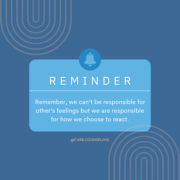 Can you think of a recent conversation in which you felt judged, bullied, blamed, or criticized by your partner? Do you find yourself becoming defensive within communication or reacting in anger during difficult conversations, only to feel more disconnected and dissatisfied in your relationship(s)?
Can you think of a recent conversation in which you felt judged, bullied, blamed, or criticized by your partner? Do you find yourself becoming defensive within communication or reacting in anger during difficult conversations, only to feel more disconnected and dissatisfied in your relationship(s)?
If so, learning more about non-violent communication can be helpful. In Marshall Rosenburg’s Book Nonviolent-Communication: A Language of Life the author explains that nonviolent communication integrates consciousness, language, communication, and means of influence.
Consciousness is defined as “A set of principles that support living a life of compassion, collaboration, courage, and authenticity”. Non-violent communication carefully uses language, choosing to use words and communicate in a way to contributes to increasing connection rather than further creating division. Power is shared with others, instead of using power to gain control over others.
Conflicts in a relationship are the most common concerns that bring individuals, couples, and families to therapy. Dyads such as a mother-daughter relationship as well as other individuals as part of a dyad of larger relational unit or family system may seek therapy to improve relationships, especially when it comes to conflict within difficult conversations.
The basis of non-violent communication is that we have the compacity for compassion. Communicating in ways that result in emotional wounds by hurting the other person is considered the opposite of non-violent communication and tends to be used when one does not have a more effective way to meet their needs.
Imagine what it would feel like to feel more connected to not only yourself, but also to others by meeting each other’s needs through empathetic listening and honest expression.
I can’t tell you how many times I have heard people “expressing” emotions and needs to another person when these were in fact an opinion, a criticism, or a moral judgement.
Non-violent communication takes patience and practice. Start by naming the emotion you are experiencing. Then focus on your own needs versus with is wrong with others. The use of I-statements and assertive communication are used. Here is a simplified example—” I feel ___ when you ____because I want ____. I would like ____”
Remember, we can’t be responsible for other’s feelings but we are responsible for how we choose to react.
To schedule an appointment with one of our professional counselors, click here.
Written By: Charlotte Johnson, MA, LPCC
We’re Here to help
Our wellness experts will be happy to take care of you. You can CLICK HERE to schedule an appointment now or call (612)223-8898.
Meet Clinicians
We’re united by our commitment to providing effective, relevant, and innovative mental health support at all stages of your journey. Click Here to find out more about who we are, where we come from, and how we live out CARE’s mission every day.
The professionals at CARE are actively collecting and creating resources to help with what you need. We’re Here for You.



